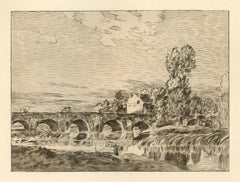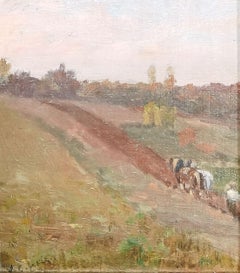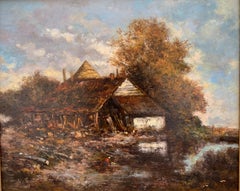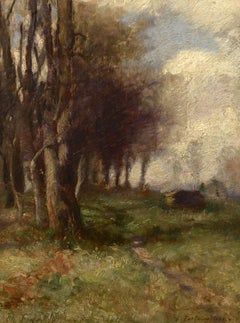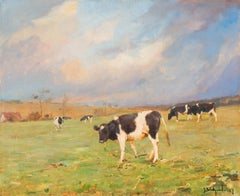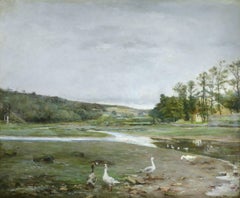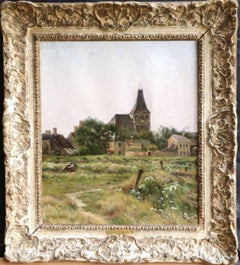Jean-Charles Cazin Art
to
2
2
1
Overall Width
to
Overall Height
to
3
2
1
1
1
2
2
1
1
1
3
7,820
5,167
2,504
1,501
1
2
1
Artist: Jean-Charles Cazin
"Le Pont de Pierre" original etching
By Jean-Charles Cazin
Located in Henderson, NV
Medium: original etching. This impression is from the rare 1897 portfolio "Art et Nature" by Leon Roger-Miles, published in Paris by Boudet in an edition of 525. Printed on Marais wo...
Category
1890s Jean-Charles Cazin Art
Materials
Etching
"Ploughing on the Hillside" Jean-Charles Cazin, Plein Air Landscape Sketch
By Jean-Charles Cazin
Located in New York, NY
Jean-Charles Cazin
Ploughing on the Hillside
Signed lower left
Oil on board
6 1/2 x 6 inches
The son of a well-known doctor, FJ Cazin, he was born at Samer, Pas-de-Calais. After st...
Category
Mid-19th Century Tonalist Jean-Charles Cazin Art
Materials
Oil, Canvas
The Barn, Oil On Bord, Signed Jean-Charles Cazin, Barbizon School, 1865
By Jean-Charles Cazin
Located in Paris, FR
Oil on panel representing a barn, signed JC Cazin on the lower left corner.
Jean Charles Cazin (1840-1901) Born in Samer (his father, from Bologna,...
Category
Late 19th Century Barbizon School Jean-Charles Cazin Art
Materials
Oil
Related Items
"a Fontainebleu, " Charles Francis DeKlyn, Barbizon, Oil, French Countryside
Located in Wiscasset, ME
Charles Francis De Klyn was born in Westchester County, New York, in 1865. A landscape, marine, portrait and figure painter, De Klyn studied in New York and Paris from 1886 to 1891, then taught at the Cleveland Art Club and the Cleveland School of Art. In 1893, he was one of the founders of the Cleveland Brush and Palette Club, and he exhibited at the National Academy of Design in 1894 and 1895. He was also a member of the Society of Western Artists.
"A Fontainebleu" by Charles Francis De Klyn is a beautifully rendered Barbizon oil...
Category
Late 19th Century Barbizon School Jean-Charles Cazin Art
Materials
Oil, Panel
'Cattle at Pasture', Danish Impressionist Landscape oil, Paris, France
By Gunnar Bundgaard
Located in Santa Cruz, CA
Signed lower right, 'G. Bundgaard' for Gunnar Bundgaard (Danish, 1920-2005) and dated '57'.
A light-filled, panoramic landscape showing Holstein cattle grazing in a grassy field beneath sun-lit clouds.
This listed Danish painter first studied at Copenhagen's Gronvang School where he was particularly influenced by the romantic academic style of Niels Pederson...
Category
1950s Impressionist Jean-Charles Cazin Art
Materials
Canvas, Oil
Axel Hansen (Dutch, 1896-1936) Country Farm Landscape w/ Cattle c.1920s
Located in San Francisco, CA
Axel Hansen (Dutch, 1896-1936) Country Farm Landscape w/ Cattle c.1920s
Fine impressionist oil painting by Danish painter Axel Hansen.
The painting shows...
Category
Early 20th Century Impressionist Jean-Charles Cazin Art
Materials
Canvas, Oil
H 21.75 in W 27 in D 3 in
"Sunset on the River"
By Leon Richet
Located in Southampton, NY
Sunset on the river by French artist, Leon Richet. Oil on wood panel. Circa 1885. Signed lower left. Framed size 13.5 by 16.5 inches.
Born in Solesme, France in 1847, Léon Richet was of the generation of painters raised during the height of the Barbizon school. He was a student of Narcisse Virgile Diaz de la Pena...
Category
1880s Barbizon School Jean-Charles Cazin Art
Materials
Oil, Board
Rural Mountain Scene with Sheep in Ireland by Post War Modern Irish Artist
By David Overend
Located in Preston, GB
Rural Mountain Scene with Sheep in Ireland by Post War Modern Irish Artist, David Overend.
Art measures 16 x 12 inches
Frame measures 25 x 21 inches
...
Category
Mid-20th Century Realist Jean-Charles Cazin Art
Materials
Canvas, Oil
19th Century landscape oil painting of sheep grazing on a clifftop
By Charles Jones (b.1836)
Located in Nr Broadway, Worcestershire
Charles Jones
British, (1836-1892)
Sheep Grazing on a Cliff Top
Oil on canvas, signed with monogram
Image size: 7.5 inches x 11.5 inches
Size including frame: 13.5 inches x 17.5 inches
Charles Jones was an animal painter who was born in Stepney, London in 1836. He was the son of the artist Samuel John Egbert Jones (1797-1861) and Dinah Jones. He lived with his parents and 9 siblings in Mile End and was a pupil of his father. In September 1859, he married Frances Rosalinda Downe, who was born in America. His son Arthur Bertram Loud (1863-1930) also became an artist. They lived at 12 Hayes Place, Lisson Grove from where he made his debut in London at the Royal Academy in 1861. He also exhibited at the British Institution, Suffolk Street, New Watercolour Society, Royal Institute of Oil Painters and the Royal Institute of Painters in Watercolours.
By 1867, he had become a successful artist and had moved to 7 Paragon Place, Brixton Hill. From 1874, he lived at Heathercroft, Balham Hill where he spent the rest of his life. As well as the major London galleries, he also exhibited provincially at various locations including: the Royal Cambrian Academy where he was elected a member in 1886, the Glasgow Institute of Fine Arts, Manchester City Art Gallery, Royal Hibernian Academy, Royal Society of British Artists, Birmingham and the Walker Art Gallery, Liverpool. Some of the smaller more intimate galleries he exhibited at were Arthur Tooth & Sons and Thomas Richardson...
Category
19th Century Victorian Jean-Charles Cazin Art
Materials
Canvas, Oil
H 13.5 in W 17.5 in D 2 in
IV unique Printers Proof Color field geometric abstraction pencil signed pochoir
By Larry Zox
Located in New York, NY
Larry Zox
Untitled IV, ca. 1979
Pochoir on Arches Paper with Deckled Edges. Hand signed and annotated Printers Proof in pencil on the lower front.
28 1/2 × 22 1/2 inches
Unframed
This beautiful Larry Zox pochoir on Arches paper with deckled edges a unique Printers Proofs - signed by the artist in pencil on the lower front.
We do not know the size of the regular edition, or whether there is a regular edition, but this is indeed a unique PP.
LARRY ZOX BiIOGRAPHY
A painter who played an essential role in the Color Field discourse of the 1960s and 1970s, Larry Zox is best known for his intensely and brilliantly colored geometric abstractions, which question and violate symmetry. Zox stated in 1965: “Being contrary is the only way I can get at anything.” To Zox, this position was not necessarily arbitrary, but instead meant “responding to something in an examination of it [such as] using a mechanical format with X number of possibilities.”[2] What he sought was to “get at the specific character and quality of each painting in and for itself,” as James Monte stated in his introductory essay in the catalogue for Zox’s 1973–74 solo exhibition at the Whitney Museum of American Art.[3] Zox also at times used a freer, more intuitive method, while maintaining coloristic autonomy, which became increasingly important to him in his later career.
Zox began to receive attention in the 1960s, when he was included in several groundbreaking exhibitions of Color Field and Minimalist art, including Shape and Structure (1965), organized by Henry Geldzahler and Frank Stella for Tibor de Nagy, New York, and Systemic Painting (1966), organized by Lawrence Alloway for the Guggenheim Museum. In 1973–74, the Whitney’s solo exhibition of Zox’s work gave recognition to his significance in the art scene of the preceding decade. In the following year, he was represented in the inaugural exhibition of the Hirshhorn Museum, which acquired fourteen of his works.
Zox was born in Des Moines, Iowa. He attended the University of Oklahoma and Drake University, and then studied under George Grosz at the Des Moines Art Center. In 1958, Zox moved to New York, joining the downtown art scene. His studio on 20th Street became a gathering place for artists, jazz musicians, bikers, and boxers. He occasionally sparred with visiting fighters. He later established a studio in East Hampton, a former black smithy used previously by Jackson Pollock.
Zox’s earliest works were collages consisting of pieces of painted paper stapled onto sheets of plywood. He then produced paintings that were illusions of collages, including both torn- and trued-edged forms, to which he added a wide range of strong hues that created ambiguous surfaces. Next, he omitted the collage aspect of his work and applied flat color areas to create more complete statements of pure color and shape. He then replaced these torn and expressive edges with clean and impersonal lines that would define his work for the next decade.
From 1962 to 1965, he produced his Rotation series, at first creating plywood and Plexiglas reliefs, which turned squares into dynamic polygons. He used these shapes in his paintings as well, employing white as a foil between colors to produce negative spaces that suggest that the colored shapes had only been cut out and laid down instead of painted. The New York Times noted in 1964: “The artist is hip, cool, adventurous, not content to stay with the mere exercise of sensibility that one sees in smaller works.”[4]
In 1965, he began the Scissors Jack series, in which he arranged opposing triangular shapes with inverted Vs of bare canvas at their centers that threaten to split their compositions apart. In several works from this series, Zox was inspired by ancient Chinese water vessels. With a mathematical precision and a poetic license, Zox flattened the three dimensional object onto graph paper, and later translated his interpretation of vessel’s lines onto canvas with masking tape, forming the structure of the painting.
The Diamond Cut and Diamond Drill paintings...
Category
1970s Color-Field Jean-Charles Cazin Art
Materials
Etching, Pencil, Monoprint
19th century French Barbizon School Painting oil on Canvas Landscape circa 1840
Located in Portland, OR
19th century French Barbizon School Painting, oil on canvas signed "Marin", Circa 1840. A very attractive bucolic, pastoral landsacpe scene with sheep grazing on the banks of a lake ...
Category
Early 19th Century Barbizon School Jean-Charles Cazin Art
Materials
Canvas, Oil
H 19.5 in W 24 in D 3 in
Paul Klee Etching "Die Szene mit der Laufenden"
By (after) Paul Klee
Located in Berlin, DE
Helio-etching on hand-made paper, 1925 by Paul Klee. Signatur is printed, lower right: Klee
From portfolio Paul Klee, Handzeichnungen 1921-1930; Here no 28
Image: 5.63 x 7.48 in ( 14...
Category
Early 20th Century Expressionist Jean-Charles Cazin Art
Materials
Etching
Mother dog and her puppies, 19th Century French Barbizonf armhouse painting
Located in Norwich, GB
An charming 19th century dog painting depicting a mother dogue and her exuberant topsy turvy pups by the farmhouse barns or cowsheds , with a young child given them a fuss!
Dating from ca 1860-70, the oil on canvas is unsigned, but bears on the verso a rather special stamp from colour and artists supplies merchant Paul Durand-Ruel (1831-1922). Paul Durand-Ruel is known as the legendary art dealer who launched, almost single handedly, the Impressionist movement. He represented Monet, Pissarro, Sisley, Renoir in his Paris, London and New York Galleries.
Like his father Jean Marie Durand, Durand Ruel had started as both a merchant of art supplies, and dealer. Often, these two activities overlapped, as he would supply cash strapped artists who left paintings as security. Paul Durand Ruel was one of the first to discover Barbizon artist...
Category
1860s Barbizon School Jean-Charles Cazin Art
Materials
Canvas, Oil
H 27.17 in W 31.89 in D 0.4 in
Breezy Morning (Classical Realist Oil Landscape of Louse Point, Hamptons, NY)
By Susan Hope Fogel
Located in Hudson, NY
"Breezy Morning" by Susan Hope Fogel
Painted in Louse Point, Hamptons, NY
oil on canvas panel
9 x 12 inches, 17.5 x 21.5 x 1 inches in gold leaf frame
wire on reverse for easy instal...
Category
2010s Barbizon School Jean-Charles Cazin Art
Materials
Canvas, Oil
H 17.5 in W 21.5 in D 1 in
Mountain landscape, XIX c. - Oil on canvas, 27x35 cm., framed.
By Leon Joubert
Located in Nice, FR
Léon Joubert (1870-1920) was a pupil of Léon Germain Pelouse ans Fernand Cormon. He exposed at the Salon des artistes français very often from 1876. he was a landscape painter, most...
Category
1890s Barbizon School Jean-Charles Cazin Art
Materials
Oil
Previously Available Items
Les Oies
By Jean-Charles Cazin
Located in Marlow, Buckinghamshire
Oil on panel. Signed lower left. Framed dimensions are 29 inches high by 33 inches wide.
Cazin studied initially at the college for the decorative arts, then worked under Lecoq de B...
Category
Late 19th Century Barbizon School Jean-Charles Cazin Art
Materials
Oil, Panel
Wildflowers in a Village
By Jean-Charles Cazin
Located in Marlow, Buckinghamshire
Oil on canvas. Signed lower left.
Cazin studied initially at the college for the decorative arts, then worked under Lecoq de Boisbaudran. He was appointed to a professorship at the ...
Category
Late 19th Century Impressionist Jean-Charles Cazin Art
Materials
Canvas, Oil
Ploughing
By Jean-Charles Cazin
Located in Marlow, Buckinghamshire
A lovely depiction of horses ploughing a field. Oil on panel. Signed with initials lower left.
Cazin studied initially at the college for the decorative arts, then worked under Leco...
Category
Late 19th Century Barbizon School Jean-Charles Cazin Art
Materials
Oil, Panel
Jean-charles Cazin art for sale on 1stDibs.
Find a wide variety of authentic Jean-Charles Cazin art available for sale on 1stDibs. You can also browse by medium to find art by Jean-Charles Cazin in etching, oil paint, paint and more. Not every interior allows for large Jean-Charles Cazin art, so small editions measuring 8 inches across are available. Customers who are interested in this artist might also find the work of Charles François Daubigny, Theophile Narcisse Chauvel, and Leon Richet. Jean-Charles Cazin art prices can differ depending upon medium, time period and other attributes. On 1stDibs, the price for these items starts at $100 and tops out at $6,438, while the average work can sell for $3,269.
